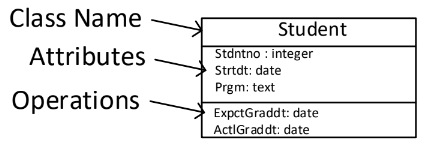
The Unified Modeling Language (UML) is a graphical language for modeling software. The UML has a variety of notations of which one (the class model) concerns databases. The UML class model specifies classes (entity types) and their relationship types (Blaha, 2013).
Figure 41 illustrates the characteristics of a UML Class Model:
- A Class diagram resembles an ER diagram except that the Operations or Methods section is not present in ER.
- In ER, the closest equivalent to Operations would be Stored Procedures.
- Attribute types (e.g., Date, Minutes) are expressed in the implementable application code language and not in the physical database implementable terminology.
- Default values can be optionally shown in the notation.
- Access to data is through the class’ exposed interface. Encapsulation or data hiding is based on a ‘localization effect’. A class and the instances that it maintains are exposed through Operations.
The class has Operations or Methods (also called its “behavior”). Class behavior is only loosely connected to business logic because it still needs to be sequenced and timed. In ER terms, the table has stored procedures/triggers.
Class Operations can be:
- Public: Externally visible
- Internally Visible: Visible to children Objects
- Private: Hidden
In comparison, ER Physical models only offer Public access; all data is equally exposed to processes, queries, or manipulations.
